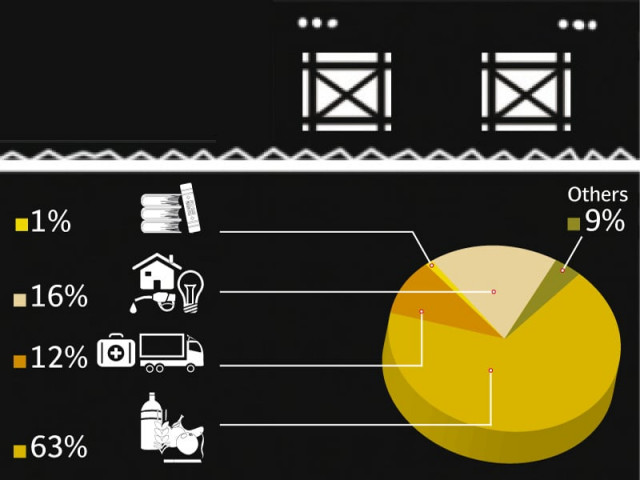The rural economy: People spend heavily on food, little on education
Survey shows average monthly household expenditure is Rs18,930.

Rural households spend almost two-third of their total expenditure on food while spending on education and entertainment remains at the bottom of their priority list, according to the latest Rural Household Panel Survey.
The survey, conducted this year under the Pakistan Strategy Support Programme, which is funded by the United States, shows that average monthly household expenditure in rural areas excluding Balochistan is Rs18,930.
The share of expenditure on food, beverages and tobacco is 63% of total expenses followed by housing, fuel and lighting that consume 16%. Another 12% is spent on medical, transport and communications while only 1% is spent on education.
Resultantly, a majority of the population remains illiterate, with only 49% attending school.
The PPP-led coalition government has claimed that due to its policies of the past around five years the living standards in rural areas have improved a lot. But the findings of the survey suggest otherwise, as households have little to spend on needs other than basic ones.
Expenditure patterns also vary across three surveyed provinces. Rural households in Sindh spend almost three-fourth of their expenditure on food as compared to 60% in Punjab and 57.5% in Khyber-Pakhtunkhwa.
In terms of education, the households in these provinces spend very little. In Sindh, the ratio is the lowest standing at just 0.4% compared to 1.5% in Punjab and 2.4% in Khyber-Pakhtunkhwa.

The data also shows that households in Khyber-Pakhtunkhwa spend more than those in Punjab and Sindh. There are also wide inequalities as the richest 20% households in rural areas spend twice as compared to the poorest 20% households.
A large majority of households have experienced some kind of negative shock in the past two years, according to the survey. The most common negative shock was medical expenses due to illness or injury with 57% of households having experienced this shock.
The second most common shock was lost or damaged home due to floods, which was experienced by 25% of households, followed by wedding expenses, excluding dowry, which were borne by 18% households.
The findings show that the households did not have strategies to cope with difficulties. They opted either to increase the number of daily wagers or cut non-essential expenditure. Only 11% of the respondents said they borrowed money to cope with negative shocks.
Another interesting finding of the survey is that only 44% of rural households earn their livelihoods from farm income. As many as 22% earn their incomes from agriculture labour, another 19% from non-agriculture enterprise and 15% earn their livelihoods from non-agriculture wage employment.
Of the total farm households, 62% are in Punjab, 26% in Sindh and only 12% in Khyber-Pakhtunkhwa.
Published in The Express Tribune, December 14th, 2012.



















COMMENTS
Comments are moderated and generally will be posted if they are on-topic and not abusive.
For more information, please see our Comments FAQ